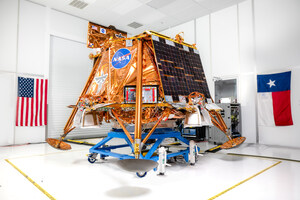WASHINGTON, Oct. 7, 2014 /PRNewswire-USNewswire/ -- NASA has selected four partners to develop game changing technologies with the potential to increase the oxygen recovery rate aboard human spacecraft to at least 75 percent while achieving high reliability. These oxygen recovery and recycling technologies will drive exploration and enable our human journey to Mars and beyond.
"Improving oxygen recovery while achieving high reliability is critical for any long-duration human spaceflight missions where oxygen resupply from Earth isn't available," said NASA Associate Administrator for Space Technology Michael Gazarik. "NASA recognizes that sustained technology investments must be made to mature the capabilities required to reach the challenging destinations that await exploration; such as cis-lunar space, an asteroid, and Mars. These ambitious projects will enable the critical life support systems needed for us to venture further into space and explore the high frontier and are another example of how technology drives exploration."
Phase I awards are up to $750,000, providing awardees with the funding for 15 months to complete the engineering development unit hardware phase. Technologies selected to continue to Phase II will develop prototype hardware with NASA support that provides up to $2 million per award for up to 24 months.
The organizations selected to work on the development of advanced life-support technologies are:
- NASA's Glenn Research Center, Cleveland: "Oxygen Recovery from Carbon Dioxide Using Ion Exchange Membrane Electrolysis Technology"
- Glenn Research Center: "A Combined Solid Oxide Co-Electrolyzer and Carbon Formation Reactor System for Spacecraft Life Support Oxygen Regeneration"
- UMPQUA Research Co., Myrtle Creek, Oregon: "Continuous Bosch Reactor"
- University of Texas at Arlington: "Microfluidic Electrochemical Reactor for Oxygen Recovery via Carbon Dioxide Electrolysis"
Future maturation of these technologies may use the International Space Station National Laboratory as a proving ground to retire risk and gain experience with capabilities needed for deep-space exploration.
The advanced technologies found in these proposals are called for in the agency's space technology roadmaps and space technology strategic investment plans. The National Research Council's "NASA Space Technology Roadmaps and Priorities" identified long-duration environmental control and life support systems as one of the top five areas capable of having the greatest impact on deep space exploration.
Proposals for this solicitation were received from NASA centers, universities, research groups and industry. These awards are managed by the Game Changing Development Program within NASA's Space Technology Mission Directorate. NASA's Langley Research Center in Hampton, Virginia, manages the Game Changing Development Program.
During the next 18 months, NASA's Space Technology Mission Directorate will release several more solicitations, investing in high priority technology areas where advances are needed to achieve more capable, reliable and affordable science, exploration and commercial space capabilities.
NASA's Space Technology Mission Directorate remains committed to developing the critical, broadly applicable technologies required to enable future exploration missions beyond low-Earth orbit. The directorate continues to solicit the help of the best and brightest minds in academia, industry, and government to drive innovation and enable solutions in a myriad of important technology thrust areas. These planned investments are addressing high priority challenges for achieving safe and affordable deep-space exploration.
Logo - http://photos.prnewswire.com/prnh/20081007/38461LOGO
SOURCE NASA
WANT YOUR COMPANY'S NEWS FEATURED ON PRNEWSWIRE.COM?
Newsrooms &
Influencers
Digital Media
Outlets
Journalists
Opted In




Share this article